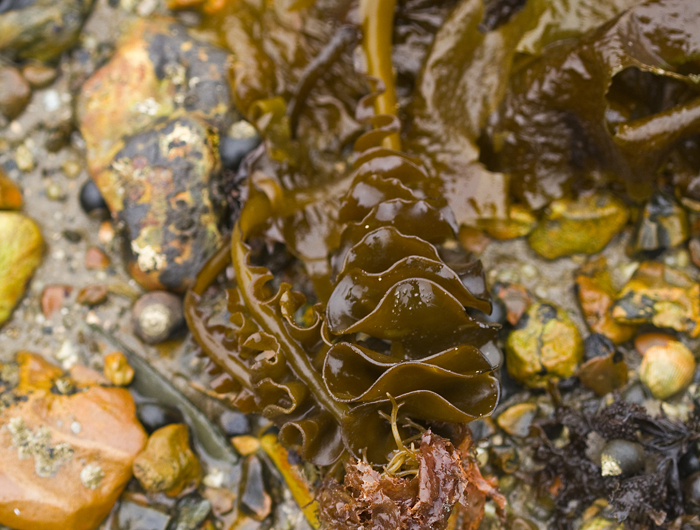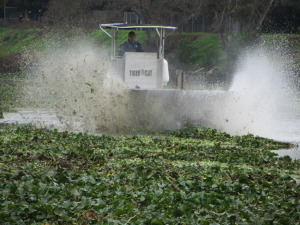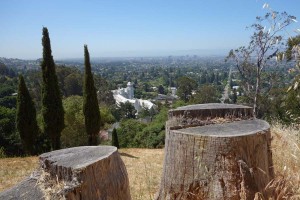A long, wavy greenish-brown kelp dangles off the docks at South Beach Marina by AT&T Park in San Francisco.
It may seem like the seaweed belongs there, but it’s an invasive kelp from Asia, known as Undaria pinnatifida. It’s so ubiquitous that efforts to remove it at South Beach Marina have been virtually abandoned.
“[The] ideal situation is to start on the edge of a population and work on, but we never had the resources at South Beach Marina,” said Chela Zabin, a marine biologist with the Smithsonian Environmental Research Center.
Recently, however, there’s been a renewed effort to address this invasive, edible seaweed, also known as wakame. Since its discovery in 2009, undaria control has mainly been a volunteer effort. Zabin and others have tackled the problem in well known spots, such as the San Francisco Marina and Pillar Point at Half Moon Bay. Now she’s managed to bring others to the cause, namely an invasive species management coalition, the Bay Area Early Detection Network.
With the expected arrival of a federal fisheries grant for just under $20,000, BAEDN plans to provide technical support and funding to spot and remove undaria at Pillar Point on Half Moon Bay. Part of the money will go to coordinate boaters, divers and anyone who is interested in volunteering time and effort to control the spread of Undaria in San Mateo County.
Zabin thinks if they get it right with Undaria, the effort might have larger implications.
“If we organize this network of people to look for Undaria, we will already have the structure in place to look for other nonnatives,” Zabin said.
Undaria is an especially good traveler, and can be hard to spot. It attaches to floating docks, boats or anything in the water. And it reproduces by spores, so it can spread through the water very easily. It has been found in smaller marinas where it attaches to yachts and sailboats.
Once it gets out there, undaria outcompetes the native kelp that some fish need for shelter, food and egg-laying. The potential impacts of a ballooning undaria population threaten the underwater ecosystem of the Bay and the

larger estuary. That makes it bad for businesses, too. Aquaculture has taken a hit from undaria infestations in Argentina and the Netherlands. Zabin said she’s warning oyster farmers in Tomales Bay about the dangers of an undaria invasion.
“If it were to get to Tomales Bay, that could be pretty serious,” she said.
The idea of removing a marine invasive species is relatively new and it is perhaps trickier to see the connections in a marine environment, Zabin said. This sort of “out of sight, out of mind” bias is beginning to change.
She cites an invasive seaweed caulerpa, nicknamed the “killer seaweed,” that was found in San Diego in 2000. With the help of herbicides and $6 million, the California Department of Fish and Game declared the invasive eradicated six years later. Undaria could be just as difficult to uproot.
“But I think it’s still possible,” Zabin said.

At the 2011 State of the Estuary conference, Zabin approached the BAEDN about working together on the undaria removal project. BAEDN applies a systematic approach to tackling invasive species, beginning with cataloguing where the invasive is present and prioritizing what areas should be worked on first. Zabin hopes to bring techniques like this, normally used to manage landlubbing invasives, to the underwater world.
Controlling undaria will come down to regularly surveying locations, and then pulling it out. One of BAED’s high priority spots is Half Moon Bay, where the population quickly expanded before its discovery. Meanwhile, divers at San Francisco’s Aquarium of the Bay monitor an Undaria population bordering the building at the Hyde Street pier. Zabin hopes that other entities with sizeable waterfront property will also “adopt their backyard.”
Although it is edible (goma wakame is seaweed salad at sushi restaurants), Zabin does not eat the undaria she pulls. Because she pulls them every month, the plants are usually small, and they are taken from contaminated areas in the marinas. Instead, Zabin’s discarded wakame typically ends up as garden compost, where it’s finally bested on land.
A website is available for those who would like to help control the spread of undaria, with plenty of information for aquaculturalists and boaters as well.





-300x221.jpg)